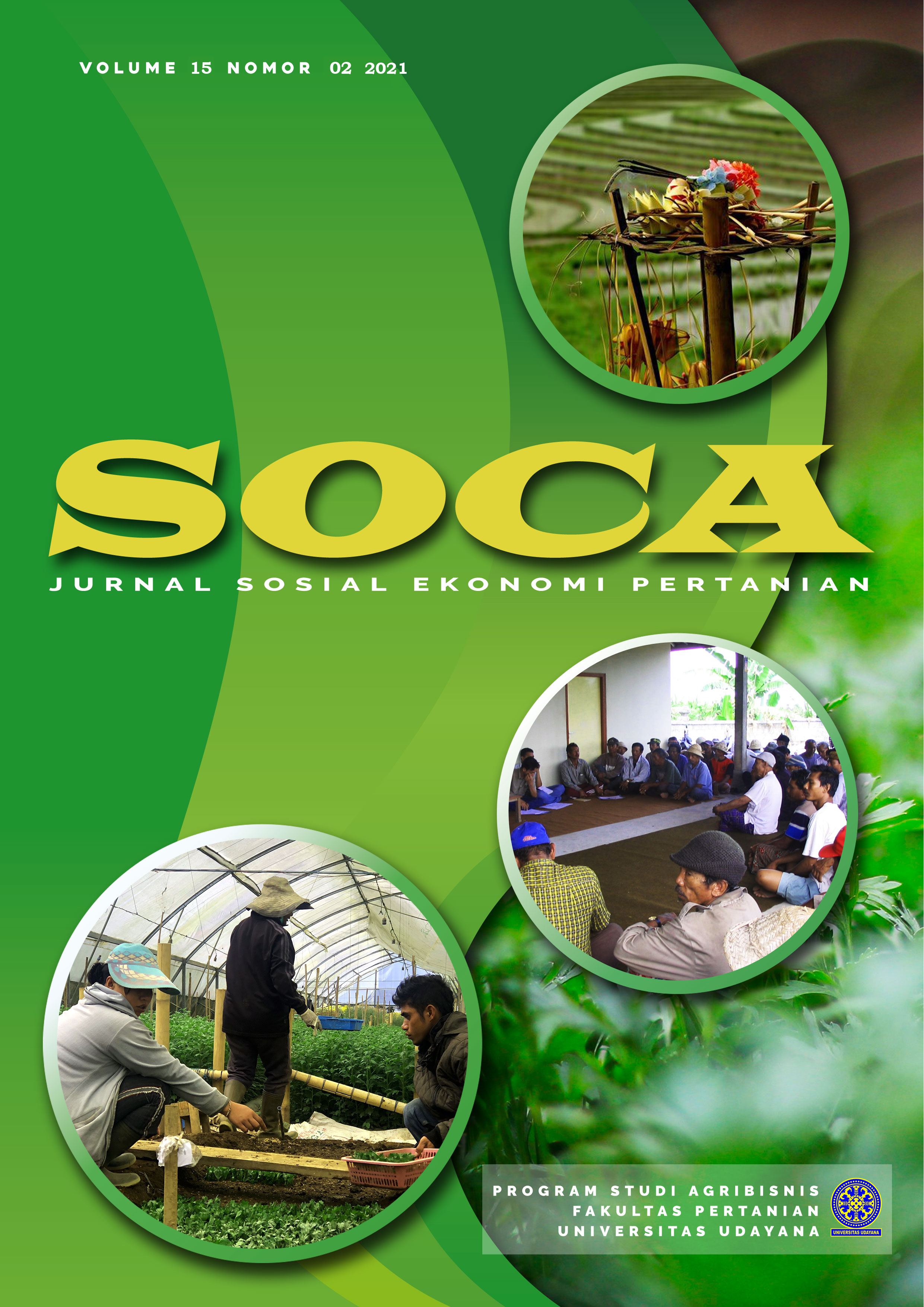Business Development Strategy on Traditional Coconut Oil (Lengis Tanusan) Production during the Covid-19 Outbreak
Abstract
Covid-19 outbreak leads to various issues in the traditional coconut oil business. A low-level purchasing power, low-level production of the oil, and poor marketing skill contribute to hindrances in running the business. This study aimed to investigate the business development strategy of traditional coconut oil during the Covid-19 outbreak in Sulang Village. Eight key informants participated in this study. Data was collected through the in-depth interview, documentation, and observation and analyzed through the SWOT dan QSPM analysis. Results revealed that the internal factors that play as the strength factor in this business were the unique savory taste of the traditional coconut oil, while the weakness factor was the low production of the oil during the Covid-19 outbreak. The external factor identified as the opportunity in this business was its close location to Paksebali and Pasek Gunaksa market. The threat factor found was the healthy lifestyle that tended to recommend a low fatty food diet. According to the alternative strategy analysis, there were 11 strategies found in developing and maintaining the traditional coconut oil business in Sulang Village. Consignments with merchants around Tukad Yeh Unda was selected as the priority strategy to maintain and improve this business. Strategies listed in this study expected to be a recommendation for the traditional coconut oil owners to manage their business during the Covid-19 outbreak.
Downloads
References
Barlina, R., & Torar, D. (2009). Diversifikasi Produk Virgin Coconut Oil ( VCO )Products Diversification of. Balai Penelitian Tanaman Kelapa Dan Palma Lain Abstrak.
Damanik, S. (2007). Strategi Pengembangan Agribisnis Kelapa (Cocos nucifera) untuk Meningkatkan Pendapatan Petani di Kabupaten Indragiri Hilir, Riau. Perspektif, 6(2), 94–104.
Effendi, U., Astuti, R., & Candra Melati, D. (2017). Development Strategies of Chocolate Business Using Quantitative Strategic Planning Matrix (QSPM) and Multi Attribute Utility Theory (MAUT) at “Kampung Coklat”, Blitar. Industria: Jurnal Teknologi Dan Manajemen Agroindustri, 6(1), 31–40. https://doi.org/10.21776/ub.industria.2017.006.01.5
Hamka, H. (2012). Analisis faktor produksi tanaman kelapa (Cocos nucifera) terhadap pendapatan petani. Agrikan: Jurnal Agribisnis Perikanan, 5(1), 49. https://doi.org/10.29239/j.agrikan.5.1.49-56
Hanoatubun, S. (2020). Dampak Covid – 19 Terhadap Perekonomian Indonesia. Journal of Education, Psychology, and Counselling, 2 (1), 146–153.
Hattab, S., & Palu, U. T. (2019). Pemberdayaan Kelompok Pengrajin Minyak Kelapa Dalam. 2(1), 24–32.
Ika Fatmawati P., Didik Wahyudi, A. H. A. (2009). Analisis Kelayakan Usaha Dan Strategi Pengembangan Agroindustri Minyak Kelapa Murni (Virgin Coconut Oil) Di Kabupaten Sumenep. Cemara, 6(1), 7–13.
Karouw, S. (2013). Minyak Kelapa Sebagai Sumber Asam Lemak Rantai Medium. Prosiding Konferensi Nasional Kelapa VIII, viii, 73–78.
Nasir, R. (2018). Analyses The Production Of Earnings In Coconut Farmer District Of Bacan The Middle East Of Sub Halmahera South. Ekonomi Pembangunan, VI(1), 53–76.
Sinaga, O., Antara, M., & Dewi, R. K. (2020). Strategi Pengembangan Usaha Garam Rakyat Di Desa Kusamba, Kecamatan Dawan, Kabupaten Klungkung. Agrisocionomics: Jurnal Sosial Ekonomi Pertanian, 4(1), 96–110. https://doi.org/10.14710/agrisocionomics.v4i1.6081
Suyanto. (2005). Metode Penelitian Sosial: Berbagai Alternatif Pendekatan. Prenada Media.
Yuni Erawati, N. M., Suamba, I. K., & Sri Astiti, N. W. (2018). Strategi Pengembangan Usaha Pupuk Organik Pada Ud Darma Puri Farm Di Desa Tangkas, Kecamatan Klungkung, Kabupaten Klungkung. Jurnal Manajemen Agribisnis (Journal Of Agribusiness Management), 6(2), 69.
https://doi.org/10.24843/jma.2018.v06.i02.p10
Yusuf, H., Masyarakat, F. K., & Palu, U. M. (2018). Kelompok pengrajin minyak kelapa tanpa kolestrol 1. 1(1), 25–32.













